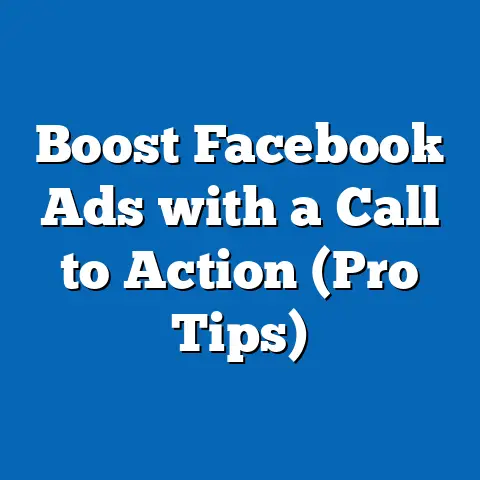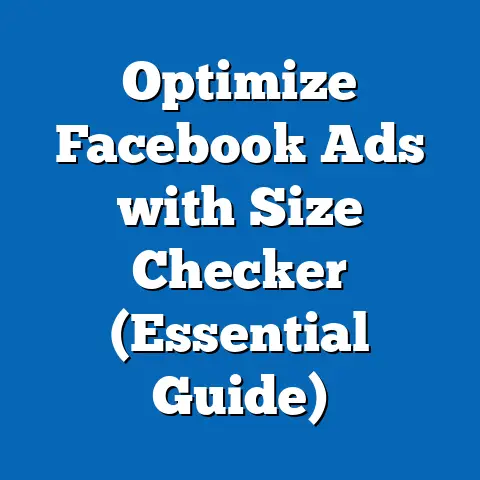Unlock Facebook Ads Insights with Google Analytics (Data Goldmine)
In the ever-evolving landscape of digital marketing, businesses are under constant pressure to maximize the return on investment (ROI) of their advertising budgets. Facebook Ads, with its vast user base of over 2.9 billion monthly active users as of 2023, offers unparalleled opportunities for targeted advertising. However, without proper tracking and analysis, even the most well-crafted campaigns can fall short of delivering optimal results.
This is where integrating Facebook Ads with Google Analytics becomes a game-changer. By combining the granular targeting capabilities of Facebook Ads with the robust tracking and reporting features of Google Analytics, marketers can unlock a data goldmine that enhances cost-effectiveness. This article explores the synergy between these two platforms, delving into their defining characteristics, historical context, and the broader societal and business implications of leveraging such data-driven strategies.
Section 1: The Cost-Effectiveness of Integrating Facebook Ads with Google Analytics
Cost-effectiveness in digital marketing is not merely about reducing expenses but achieving higher returns per dollar spent. Facebook Ads, while powerful, can become costly if campaigns are not optimized based on performance data. Google Analytics, a free tool for most users, provides a solution by offering detailed insights into user behavior, traffic sources, and conversion metrics that complement Facebook’s native reporting.
According to a 2022 study by eMarketer, businesses that integrate cross-platform analytics save up to 20% on ad spend by identifying underperforming campaigns early and reallocating budgets to high-ROI channels. For small and medium-sized enterprises (SMEs) with limited marketing budgets, this integration is particularly transformative. It allows for real-time adjustments, reducing wasted spend on ineffective ads.
Moreover, Google Analytics provides a unified view of customer journeys across multiple touchpoints, which is often lacking in Facebook’s isolated reporting. For instance, while Facebook Ads Manager shows clicks and impressions, Google Analytics reveals how those clicks translate into on-site actions like purchases or sign-ups. This deeper understanding enables marketers to fine-tune campaigns for maximum efficiency, ensuring every dollar contributes to measurable outcomes.
Section 2: Defining Characteristics of the Integration
The integration of Facebook Ads with Google Analytics is defined by several key characteristics that make it a potent tool for marketers. First, it bridges the gap between ad performance and website behavior, offering a holistic view of the customer funnel. This means businesses can track not just ad clicks but also post-click engagement metrics such as bounce rates, session duration, and goal completions.
Second, the integration leverages advanced attribution modeling. Google Analytics allows marketers to assign value to different touchpoints in the customer journey, moving beyond last-click attribution to more nuanced models like linear or time-decay attribution. This ensures a fairer assessment of how Facebook Ads contribute to conversions compared to other channels.
Third, the integration supports cross-device tracking, a critical feature in today’s multi-device world. With users often switching between smartphones, tablets, and desktops, understanding their behavior across devices is essential for accurate analysis. Google Analytics’ User ID feature, when paired with Facebook Ads data, provides a cohesive picture of user interactions, enhancing targeting precision.
Section 3: Historical Context of Digital Advertising and Analytics
To fully appreciate the significance of integrating Facebook Ads with Google Analytics, it’s important to understand the historical evolution of digital advertising and analytics. The early 2000s marked the rise of online advertising with platforms like Google AdWords (now Google Ads), which introduced pay-per-click (PPC) models that prioritized measurable results over traditional impression-based advertising. This era also saw the launch of Google Analytics in 2005, which democratized access to website performance data for businesses of all sizes.
Facebook entered the advertising scene in 2007 with the introduction of Facebook Ads, initially focusing on basic demographic targeting. Over the next decade, it evolved into a sophisticated platform with advanced features like Custom Audiences and Lookalike Audiences, fueled by its massive user data. However, as digital ad spend grew—reaching $626 billion globally in 2023 according to Statista—marketers faced increasing scrutiny over ROI and accountability.
The need for cross-platform analytics became evident as siloed data limited actionable insights. Google Analytics emerged as a unifying tool, integrating with various ad platforms, including Facebook, through features like UTM parameters and data imports. This historical convergence of advertising and analytics tools reflects a broader shift toward data-driven decision-making, a trend that continues to shape marketing strategies today.
Section 4: Societal and Business Implications of Data-Driven Marketing
For businesses, the implications are predominantly positive. The ability to optimize ad spend through data insights levels the playing field, allowing smaller companies to compete with larger corporations. A 2021 report by McKinsey found that SMEs using integrated analytics tools saw a 15-25% increase in customer acquisition efficiency compared to those relying on standalone platforms.
However, this reliance on data also introduces risks, such as over-optimization at the expense of creativity. Marketers may prioritize metrics over brand-building, potentially alienating audiences with overly transactional campaigns. Balancing data-driven strategies with authentic storytelling is thus a critical challenge for modern businesses.
Section 5: Technological and Economic Factors Driving the Integration
Several technological and economic factors facilitate the integration of Facebook Ads with Google Analytics. Technologically, advancements in tracking mechanisms like UTM parameters and the Facebook Pixel allow seamless data flow between platforms. UTM parameters, for instance, tag Facebook Ads URLs with identifiable codes, enabling Google Analytics to categorize incoming traffic accurately.
Economically, the freemium model of Google Analytics makes it accessible to businesses with varying budgets. While premium features are available through Google Analytics 360 for enterprise users, the free version suffices for most SMEs, reducing barriers to entry. Additionally, the competitive pressure in digital advertising—where platforms vie for ad dollars—encourages interoperability between tools, as seen with Facebook’s support for third-party tracking.
The rise of cloud computing and big data analytics also plays a role. These technologies enable real-time data processing, allowing marketers to act swiftly on insights. For instance, if Google Analytics identifies a high bounce rate from a specific Facebook campaign, adjustments can be made within hours, minimizing financial losses.
Section 6: Step-by-Step Guide to Unlocking Insights
To harness the cost-effectiveness of this integration, marketers must follow a structured approach. Below is a step-by-step guide to setting up and leveraging Facebook Ads data in Google Analytics.
-
Set Up UTM Parameters for Facebook Ads: Use Google’s Campaign URL Builder to create tagged URLs for each ad. Include parameters like source (facebook), medium (cpc), and campaign name to ensure accurate tracking in Google Analytics.
-
Install the Facebook Pixel on Your Website: The Pixel tracks user actions post-click, such as purchases or form submissions. Link it to your Facebook Ads account and ensure it’s properly configured to send data to Google Analytics via events.
-
Link Google Analytics to Your Website: If not already done, integrate Google Analytics with your website to start collecting data. Verify that goals and e-commerce tracking are set up to measure conversions.
-
Analyze Traffic in Google Analytics: Navigate to the Acquisition > Campaigns > All Campaigns report to view performance metrics for your tagged Facebook Ads. Look at metrics like sessions, bounce rate, and conversion rate to assess effectiveness.
-
Use Attribution Models: Experiment with different attribution models in Google Analytics to understand how Facebook Ads contribute to conversions compared to other channels. Adjust budgets based on these insights.
-
Optimize Campaigns: Use the data to refine targeting, creative elements, and landing pages. For example, if a campaign shows high clicks but low conversions, test different ad copy or improve the landing page experience.
This process, while technical, is achievable for marketers with basic digital skills. Numerous online resources and tutorials further simplify implementation.
Section 7: Comparing Standalone vs. Integrated Analytics Approaches
Comparing standalone analytics (using only Facebook Ads Manager) with an integrated approach highlights the latter’s superiority in achieving cost-effectiveness. Facebook Ads Manager provides detailed ad-level data, such as cost-per-click (CPC) and click-through rate (CTR), but lacks insight into post-click behavior. This can lead to misinformed decisions, as high CTRs don’t guarantee conversions.
In contrast, integrating with Google Analytics reveals the full customer journey. For example, a campaign with a low CPC might drive traffic that bounces immediately, a detail invisible in Ads Manager alone. A 2020 study by Forrester found that marketers using integrated analytics were 30% more likely to achieve above-average ROI compared to those using siloed tools.
However, integration isn’t without challenges. It requires technical setup and ongoing maintenance, which may deter resource-constrained businesses. Additionally, discrepancies between platforms—due to differing tracking methodologies—can confuse users. Despite these hurdles, the benefits of a unified data view outweigh the drawbacks for most marketers.
Section 8: Nuances and Diversity in Application Across Industries
In contrast, B2B companies may prioritize lead generation over immediate sales. For them, tracking form submissions or whitepaper downloads as goals in Google Analytics offers insights into campaign success. Industries like non-profits, meanwhile, may focus on engagement metrics, such as time on site or pages per session, to gauge awareness efforts.
This diversity underscores the need for customized analytics setups. A one-size-fits-all approach risks overlooking industry-specific nuances, emphasizing the importance of aligning integration strategies with business objectives.
Section 9: Challenges and Ethical Considerations
While the integration offers undeniable benefits, it also presents challenges and ethical dilemmas. Data discrepancies between platforms are a common issue, often arising from differences in how clicks and conversions are counted. Marketers must cross-verify data and prioritize primary goals to avoid analysis paralysis.
Privacy concerns are another significant hurdle. With regulations like the General Data Protection Regulation (GDPR) in Europe and the California Consumer Privacy Act (CCPA) in the US, businesses must ensure compliance when tracking user data. The 2023 deprecation of third-party cookies by major browsers further complicates cross-platform tracking, pushing marketers toward first-party data solutions.
Ethically, the use of detailed user data raises questions about surveillance and consent. While personalized ads can improve user experiences, they can also feel intrusive if not handled transparently. Businesses must balance data-driven marketing with respect for user autonomy, a challenge that will only grow as privacy laws evolve.
Section 10: Implications for the Future of Marketing
Looking ahead, the integration of Facebook Ads with Google Analytics is poised to shape the future of digital marketing in several ways. First, it will drive greater adoption of automation and machine learning. Tools within Google Analytics, like Smart Goals and predictive metrics, can already suggest optimizations based on historical data, a trend likely to intensify.
Second, the shift toward privacy-first tracking will influence how integration evolves. As third-party cookies phase out, solutions like Google’s Consent Mode and Facebook’s Conversions API will become critical for maintaining data accuracy while respecting user preferences. Businesses that adapt early to these changes will gain a competitive edge.
Finally, the democratization of analytics tools will empower more businesses to adopt data-driven strategies. As platforms simplify integration processes and offer educational resources, even non-technical marketers will be able to leverage these insights, potentially reshaping industry dynamics.
Conclusion: A Forward-Looking Perspective on Cost-Effective Marketing
Integrating Facebook Ads with Google Analytics represents a data goldmine for cost-effective marketing, offering unparalleled insights into ad performance and user behavior. By bridging the gap between ad clicks and on-site actions, this synergy enables businesses to optimize budgets, refine targeting, and achieve measurable results. Its historical roots in the rise of digital advertising and analytics underscore its relevance in today’s data-centric landscape.
However, the journey is not without challenges, from technical hurdles to ethical considerations around privacy. As technology and regulations evolve, marketers must remain agile, balancing data-driven precision with transparency and creativity. While uncertainties remain—particularly around future privacy frameworks—the potential of this integration to transform marketing outcomes is undeniable.
For businesses willing to invest the time and resources, unlocking Facebook Ads insights with Google Analytics offers a pathway to sustainable, cost-effective growth. As we move into an increasingly digital future, those who master this data goldmine will be best positioned to thrive in a competitive marketplace.






